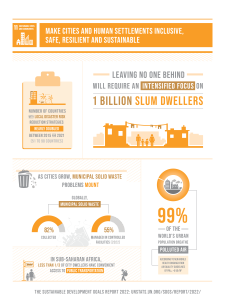CEGC 4: Inclusive, Safe, and Sustainable Cities

Connection to the United Nations Sustainable Development Goals
| Safe and clean cities support the health and well-being of their residents | Urban areas are home to much industry and infrastructure | ||
| Cities are the at the intersection of many societal issues of importance | Safe and sustainable cities provide increased opportunities for all their citizens | ||
| Safe and sustainable cities require access to clean water and sanitation |
Inclusive, safe, resilient and sustainable cities and human settlements include planning, housing, transportation, water systems green spaces for prosperity |
||
| Urban areas rely on the availability of energy to thrive | Urban areas emit the majority of the world’s greenhouse gases |
What is the Canadian Engineering Grand Challenge Statement?
The challenge for sustainable cities lies in the need to provide technical expertise, ingenuity and leadership, working with interdisciplinary teams and multiple stakeholders, in transforming cities to become healthy and liveable (EDC-DDIC, 2022).
High Level Overview of the Canadian Engineering Grand Challenge
Cities provide the foundation for modern life. They offer access to goods and services, allow for implementation of infrastructure, promote cultural exchange and understanding, and shape their surrounding environment significantly. The modern city is incredibly complex and comes with many challenges, some of which are city-specific and others which are more universally experienced. Globally, urban areas emitted more carbon dioxide than rural and suburban areas combined in 2021 (United Nations, n.d.). Cities need to be aware of and actively respond to issues of equity, diversity, and inclusion. Canada is undergoing a housing crisis with safe and affordable housing, a human right as defined by the United Nations, becoming increasingly difficult to find. The design of a city can also promote or discourage an active lifestyle from its residents. More developed public transportation modes are necessary, particularly for low-income residents. Rapid urbanization often leads to slum development, and cities are gradually moving from a linear to a circular economy as waste is becoming better managed. These are only a fraction of the complex issues that will need to be addressed by the engineers of today to build a better tomorrow.
Example Connection to a Sustainable Development Goal
CEGC 4: Inclusive, Safe, and Sustainable Cities maps to several Sustainable Development Goals, where an example of one of the connections is to SDG 11 – Sustainable Cities and Communities, which has a goal to “Make cities and human settlements inclusive, safe, resilient and sustainable” (United Nations, 2023).
 Figure: Infographic on Sustainable Development Goal 11 (United Nations, 2023)
Figure: Infographic on Sustainable Development Goal 11 (United Nations, 2023)
Keywords: urbanization, demographic, inclusivity, sustainable cities, infrastructure investment, infrastructure lock-in
Status of the Challenge Globally
Urbanization is a worldwide phenomenon, and more people live in cities now more than ever before. Climate change stresses cities in a variety of ways, and social issues are always evolving.
Status of the Challenge in Canada
Urbanization
Cities are becoming greater and greater parts of the human experience. Small communities are shrinking as people migrate to more populated urban areas. As of 2022, over 80% of Canadians lived in cities (EDC-DDIC, 2022). As more people come to reside in cities, issues of densification or urban sprawl arise. Rapid urbanization of an area can also lead to development of slum conditions, which are unsafe and undesirable locations to live in.
Diversity of Transportation
Transportation has been defining the location, form, and function of cities for many years now. Access to a large body of water for aquatic transport used to be a major requirement for a city to thrive. After the invention of the railroad, the most successful cities all had rail lines leading to and from them to allow for easy movement of goods and people. Today, cities are dominated by the car. This allows for single-occupancy transport and the densification of vehicles on our roads. Single-occupancy vehicles, while nice for allowing personal freedoms of transport whenever and wherever the driver desires, are inefficient, both from an environmental and transportation perspective. Creating a greater diversity of transportation options in cities, such as rail or even bike paths, will aid in the health and overall efficiency of the city.
Climate Change and Environmental Impact
Urban areas, like everywhere else on the planet, are becoming increasingly impacted by climate change. Increasing rates of severe weather events and rising temperatures threaten to decrease the livability of cities. Earth’s temperature has, on average, increased by 0.18°C per decade since 1981 (Climate change: Global temperature, 2022). Cities face the worst of that heat increase as the dominant presence of building materials such as asphalt and concrete heat up much easier than a forested landscape for example. Events such as flooding, hurricanes, earthquakes, etc., can damage infrastructure and housing, as well as threaten human lives. Cities of the future will need to be designed to mitigate the negative effects of the changing climate. Reducing urban areas’ contribution to climate change is also an important endeavor. In 2021, urban areas emitted between 71 and 76 percent of CO2 emissions from global final energy use (United Nations, n.d.). This equates to roughly 30 billion tons of CO2 emissions in a single year. These emissions are only serving to further increase the effects of the changing climate. Expansion of cities is also causing losses in biodiversity as only species that are evolved to coexist with humans can survive in the urban environment.
City Inclusivity
Urban areas are the areas of convergence of diverse peoples. Rich, poor, immigrants, people of varying political stances and religious beliefs, the list goes on. Cities need to develop and operate in a way that can accommodate everyone. City demographics in Canada are rapidly shifting, which brings its own set of challenges as well as benefits. Inequalities become more and more apparent as the gap between the rich and poor expands. Aging populations mean that cities need to be designed to allow for mobility of elderly inhabitants. Culture shifts and grows as diverse peoples settle in an area. All of these and more need to be considered by decision makers such as municipalities and engineers in order to create and inclusive environment for all.
Roadblocks to Success
Adapting cities to become safe, sustainable, and inclusive takes a concentrated effort over many years. Infrastructure and modes of planning are slow to adapt which makes change more difficult. Institutions such as municipalities, utilities, and engineering firms become accustomed to certain modes of operation. Changing policies and infrastructure in a city is difficult and expensive and requires public assent. Opportunities for change are present in deteriorating infrastructure, as the need for replacement is a prime occasion for upgrades or alternatives. Altogether, garnering political will is the largest obstacle to meaningful change in urban areas.
Strategies to Meet 2030 Targets
To address the challenge of creating safe and inclusive cities, Engineering Deans Canada have identified the following strategies (EDC-DDIC, 2022):
- Develop urban strategies and technologies to provide greater choice of transportation modes in low-density Canadian cities in varying climates
- Providing greater choice of transportation modes, through development of urban strategies and technologies that overcome the low densities and challenging climates.
- Increasing electrification of energy uses in cities, taking advantage of low-carbon electricity where it exists, where more progressive government regulations and policies are needed to incentivize the provision of more electrical infrastructures for the direct use of consumers.
- Enhancing the resilience of cities to climate change and other stresses.
- Providing innovative infrastructure planning and design to meet sustainability and resilience objectives.
- Embracing technological stewardship that calls on those who create and influence technology to step into a greater responsible leadership role, to not only solve problems, but to also contribute to society.
- Emphasizing political will, because all of the above will not be effectively implemented without it. Engineers can influence political decision makers and better still, become decision makers to ensure that these priority areas will be implemented.
References
- EDC-DDIC. (2022, May 6). Canadian Engineering Grand Challenges (2020-2030). Engineering Deans Canada. Retrieved February 23, 2023, from https://engineeringdeans.ca/en/canadian-engineering-grand-challenges-2020-2030-inspiring-action-to-improve-life-for-canadians-and-the-world/
- United Nations. (n.d.). Housing. UN Habitat: For a Better Urban Future. Retrieved November 26, 2022, from https://unhabitat.org/topic/housing
- United Nations. (2023). The 17 Goals, United Nations Department of Economic and Social Affairs, Sustainable Development. Retrieved February 27, 2023, from https://sdgs.un.org/goals

